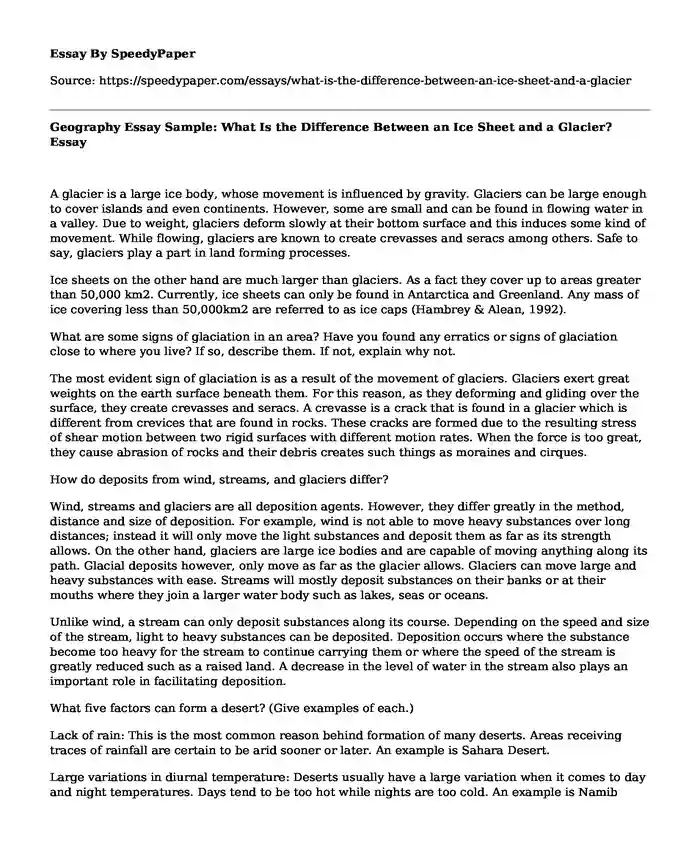A glacier is a large ice body, whose movement is influenced by gravity. Glaciers can be large enough to cover islands and even continents. However, some are small and can be found in flowing water in a valley. Due to weight, glaciers deform slowly at their bottom surface and this induces some kind of movement. While flowing, glaciers are known to create crevasses and seracs among others. Safe to say, glaciers play a part in land forming processes.
Ice sheets on the other hand are much larger than glaciers. As a fact they cover up to areas greater than 50,000 km2. Currently, ice sheets can only be found in Antarctica and Greenland. Any mass of ice covering less than 50,000km2 are referred to as ice caps (Hambrey & Alean, 1992).
What are some signs of glaciation in an area? Have you found any erratics or signs of glaciation close to where you live? If so, describe them. If not, explain why not.
The most evident sign of glaciation is as a result of the movement of glaciers. Glaciers exert great weights on the earth surface beneath them. For this reason, as they deforming and gliding over the surface, they create crevasses and seracs. A crevasse is a crack that is found in a glacier which is different from crevices that are found in rocks. These cracks are formed due to the resulting stress of shear motion between two rigid surfaces with different motion rates. When the force is too great, they cause abrasion of rocks and their debris creates such things as moraines and cirques.
How do deposits from wind, streams, and glaciers differ?
Wind, streams and glaciers are all deposition agents. However, they differ greatly in the method, distance and size of deposition. For example, wind is not able to move heavy substances over long distances; instead it will only move the light substances and deposit them as far as its strength allows. On the other hand, glaciers are large ice bodies and are capable of moving anything along its path. Glacial deposits however, only move as far as the glacier allows. Glaciers can move large and heavy substances with ease. Streams will mostly deposit substances on their banks or at their mouths where they join a larger water body such as lakes, seas or oceans.
Unlike wind, a stream can only deposit substances along its course. Depending on the speed and size of the stream, light to heavy substances can be deposited. Deposition occurs where the substance become too heavy for the stream to continue carrying them or where the speed of the stream is greatly reduced such as a raised land. A decrease in the level of water in the stream also plays an important role in facilitating deposition.
What five factors can form a desert? (Give examples of each.)
Lack of rain: This is the most common reason behind formation of many deserts. Areas receiving traces of rainfall are certain to be arid sooner or later. An example is Sahara Desert.
Large variations in diurnal temperature: Deserts usually have a large variation when it comes to day and night temperatures. Days tend to be too hot while nights are too cold. An example is Namib Desert.
Deforestation: Continuous cutting down of trees leads to the formation of deserts. This is because trees serve to attract rainfall.
Overhead sun: When the overhead sun is too direct and closely above the land surface, then the area is deemed to be a desert. An example is Kalahari Desert.
Geographical features: Mountains and hills are responsible for creation of deserts. The leeward side hardly receives any rainfall and this makes the area arid (Allaby, 2001).
References
Allaby, M. (2001). Deserts. New York: Facts on File.
Hambrey, M. J., & Alean, J. (1992). Glaciers. New York : Cambridge University Press.
Cite this page
Geography Essay Sample: What Is the Difference Between an Ice Sheet and a Glacier?. (2019, Oct 11). Retrieved from https://speedypaper.net/essays/what-is-the-difference-between-an-ice-sheet-and-a-glacier
Request Removal
If you are the original author of this essay and no longer wish to have it published on the SpeedyPaper website, please click below to request its removal:
- Summary Response Essay to the Article on Pet Allergies, Free Example
- Economics Essay Example on Policy Process and Analysis
- Free Essay in Philosophy: Utilitarianism in The One Who Walks Away from Omelas
- Sperm DNA Fragmentation:
- Abstinence versus Sex Education - Articles Review Essay Example
- Free Essay Sample - Cloud Storage
- Paper Example. Sacred Time in Abraham Joshua Heschel's "The Sabbath"
Popular categories





